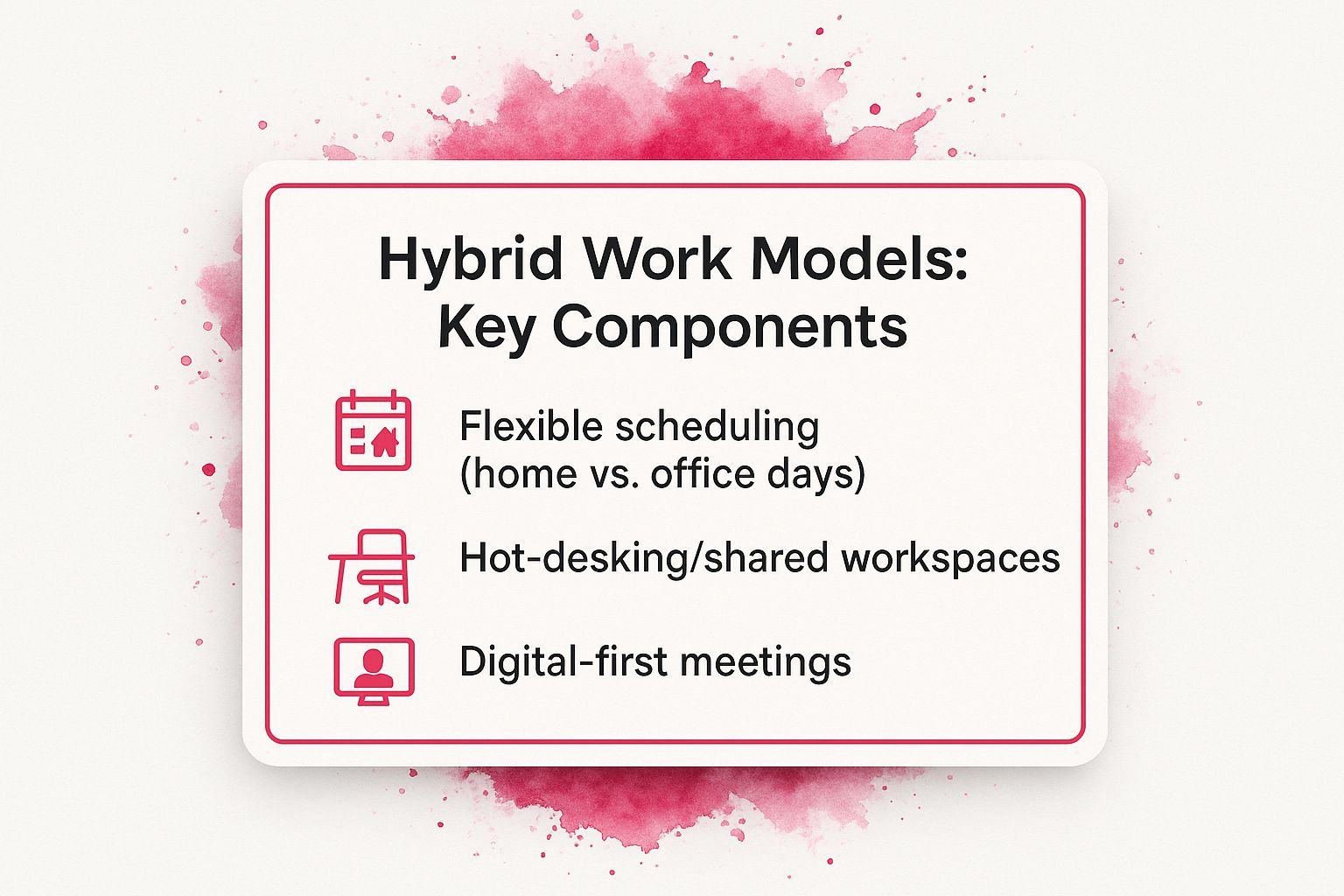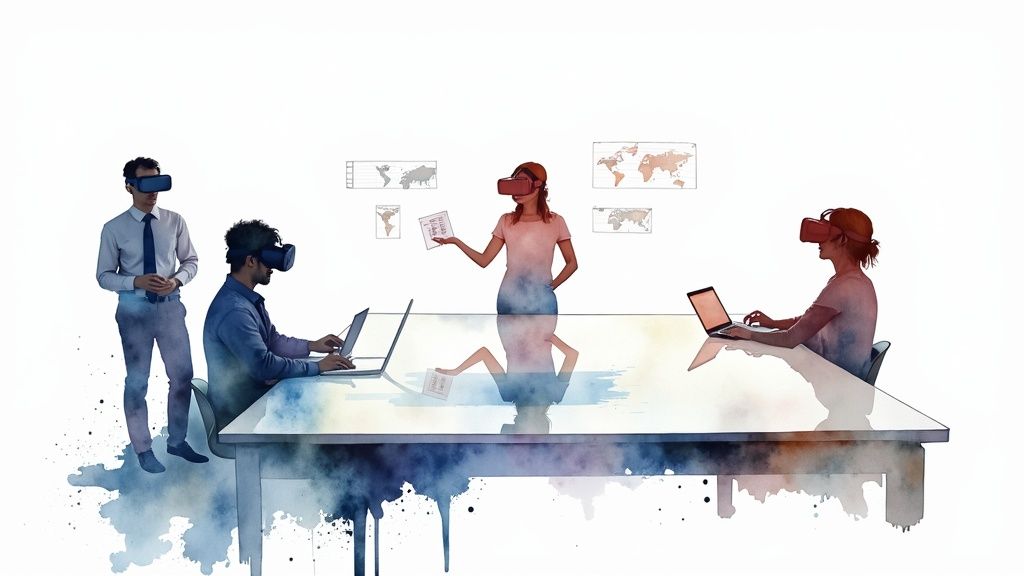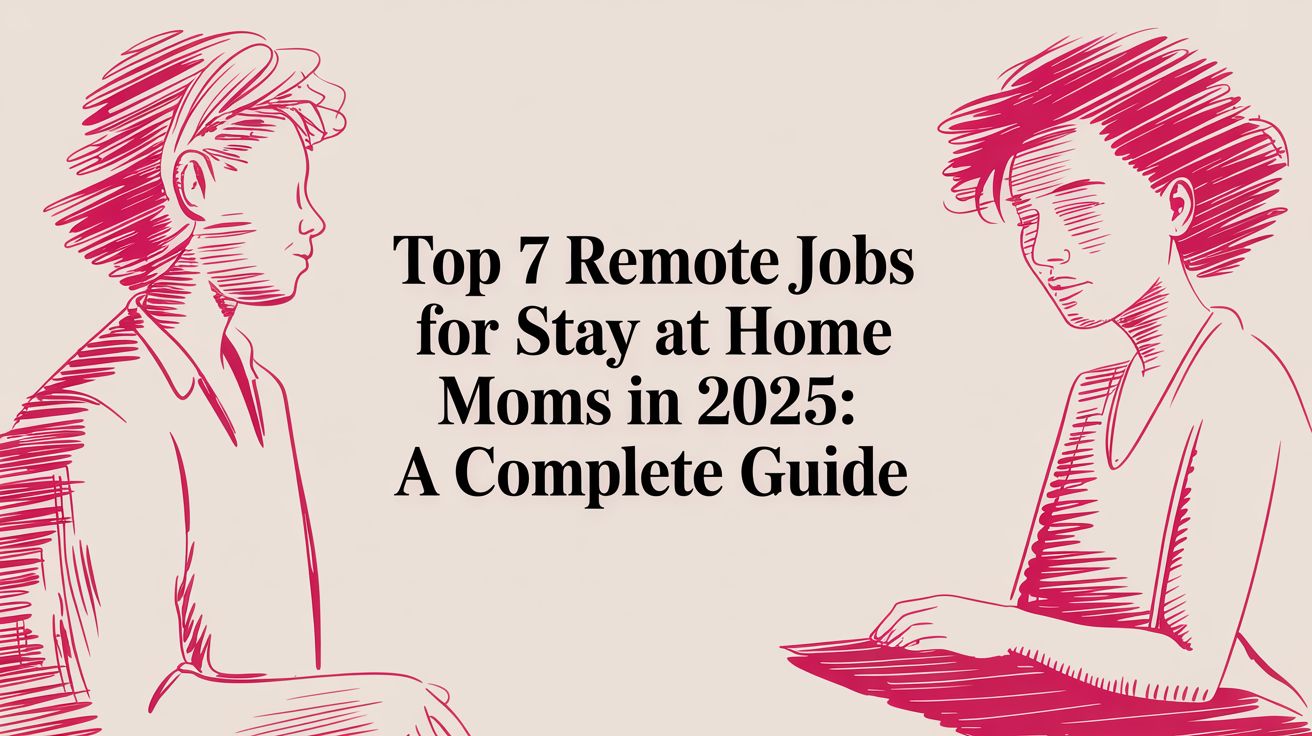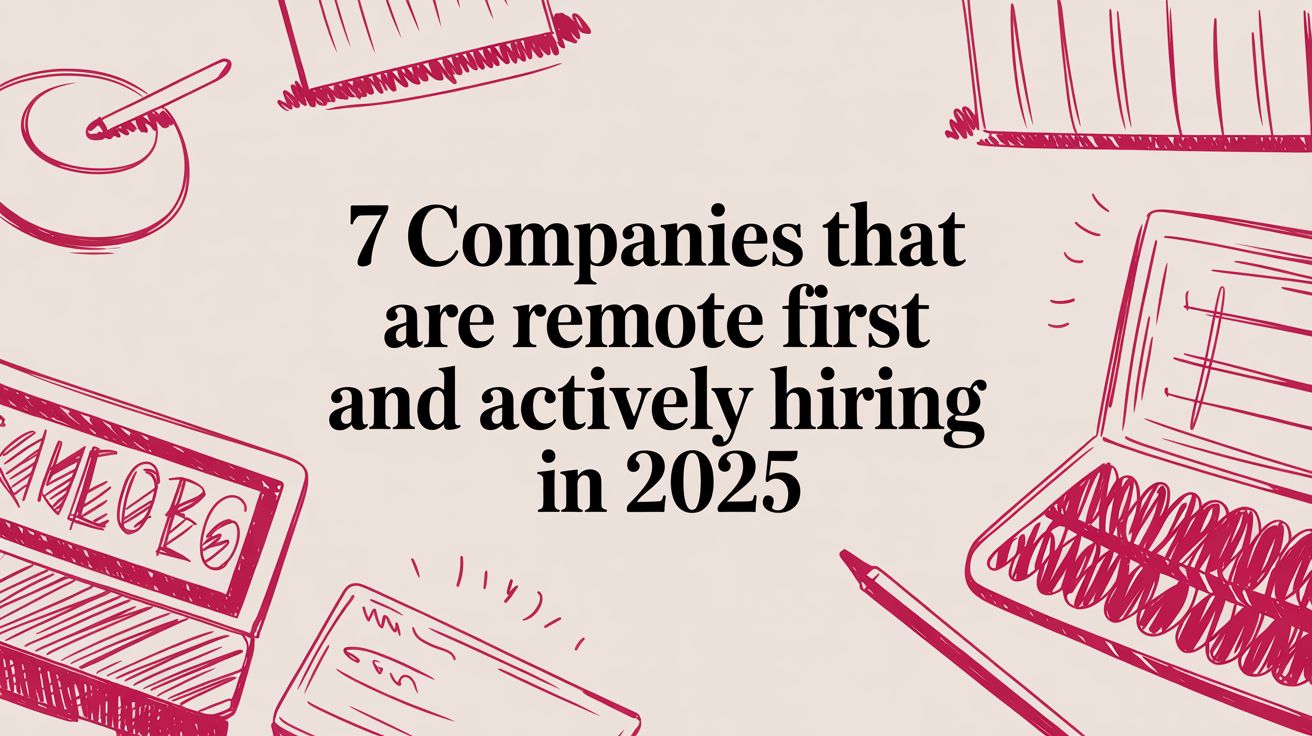Top Remote Work Trends Shaping 2025
Max
Embracing the Evolving Landscape of Remote Work
The future of work is remote. This listicle pinpoints nine key remote work trends shaping how and where we work in 2025 and beyond. Understanding these trends is crucial for both job seekers navigating the remote job market and companies adapting to a distributed workforce.
This isn’t just a list of buzzwords. Each trend includes actionable insights and practical strategies for implementation. Whether you’re an individual seeking a remote role or a company building a remote team, this information will empower you to thrive in the evolving world of remote work. We’ll explore topics from hybrid work models and asynchronous communication to the rise of the metaverse and the increasing importance of employee wellness in remote settings.
This deep dive into remote work trends will cover:
- Hybrid Work Models
- Asynchronous Work Culture
- Digital Nomadism and Location Independence
- Virtual Reality and Metaverse Workspaces
- AI-Powered Productivity and Automation
- Results-Only Work Environments (ROWE)
- Wellness-Focused Remote Work
- Global Talent Acquisition and Distributed Teams
- Micro-Offices and Neighborhood Workspaces
By understanding these nine remote work trends, you’ll gain a competitive edge. Learn how to adapt to this dynamic environment, find the perfect remote job, or build a thriving remote team.
1. Hybrid Work Models
Hybrid work models offer a flexible approach, blending remote work with in-office presence. Employees split their time between home and office locations, enjoying the benefits of both worlds. This model has emerged as a dominant force post-pandemic, offering structured flexibility while nurturing team cohesion and company culture. This balance allows companies to retain top talent who value flexibility while still fostering a sense of connection. When considering structuring a hybrid model, remember the importance of fostering a sense of community for all employees, regardless of location. As the landscape of remote work evolves, consider key factors when evaluating remote hiring practices. Source: How to Hire Remote Employees: Expert UK Business Tips from Beyond Hire.
Examples of Successful Hybrid Models
Several leading companies have successfully implemented hybrid work models:
- Microsoft: Their 3-2-1 flexibility model encourages teams to identify 3 days for collaborative in-office work.
- Salesforce: The ‘Work from Anywhere’ program empowers employees to choose their work location based on individual needs and team dynamics.
- Google: A hybrid work week requiring 3 days in the office aims to balance focused work with collaboration.
- Spotify: ‘Work from Anywhere’ allows flexibility with designated quarterly team weeks for in-person connection.
Implementing a Successful Hybrid Model
Implementing a hybrid model requires careful planning. Here are some essential tips:
- Establish clear communication protocols: Define how and when teams will communicate, ensuring both remote and in-office workers are kept informed.
- Invest in collaboration technology: Tools like Slack, Microsoft Teams, and project management software are vital for seamless communication and workflow.
- Set specific in-office days: Designated in-office days promote team alignment, fostering collaboration and connection among team members.
- Create equitable experiences: Provide all employees, regardless of location, with equal access to opportunities, resources, and recognition.
- Implement hot-desking systems: Optimize office space with hot-desking, catering to a fluctuating in-office workforce while maximizing efficiency.
The following infographic summarizes the core components of a successful hybrid work model. These elements are key for building a balanced and productive work environment in the evolving landscape of remote work trends.

The infographic highlights the importance of flexible scheduling, hot-desking/shared workspaces, and digital-first meetings – all of which are fundamental for a thriving hybrid workplace. Successfully integrating these elements creates a dynamic, adaptable, and collaborative environment for all employees. The flexibility and structured approach of hybrid work contribute significantly to its growing popularity as a dominant remote work trend.
2. Asynchronous Work Culture
Asynchronous work culture is a remote work trend transforming how teams collaborate. It’s a methodology where team members contribute and complete tasks without needing to be online simultaneously. This approach prioritizes documentation, clear communication, and flexible scheduling over real-time meetings and immediate responses. Asynchronous work empowers individuals to work when they are most productive, fostering a better work-life balance and accommodating diverse time zones. Learn more about Asynchronous Work Culture.
Examples of Successful Asynchronous Companies
Several companies thrive with asynchronous communication:
- GitLab: With over 1,300 employees, GitLab’s all-remote structure relies heavily on documentation and asynchronous workflows.
- Buffer: Known for its transparent culture, Buffer leverages asynchronous communication for internal discussions and decision-making.
- Automattic: This distributed workforce effectively utilizes asynchronous practices for project management and collaboration across various time zones.
- Basecamp: A pioneer in remote work, Basecamp advocates for asynchronous communication to minimize distractions and maximize deep work.
Implementing an Asynchronous Work Model
Transitioning to an asynchronous model requires intentional effort:
- Implement comprehensive documentation practices: Document every process, decision, and project detail for easy access and reference.
- Use project management tools: Platforms like Notion or Asana facilitate task management, progress tracking, and asynchronous communication.
- Set clear response time expectations: Establish reasonable timeframes for responding to messages and inquiries, reducing pressure for immediate replies.
- Schedule regular check-ins for alignment: While minimizing real-time meetings, periodic check-ins ensure everyone stays aligned on goals and progress.
- Create shared knowledge bases: Centralized repositories of information promote self-sufficiency and reduce the need for constant questioning.
Asynchronous work offers a powerful approach to remote collaboration, boosting productivity and flexibility. By embracing documentation, clear communication, and the right tools, teams can unlock the full potential of this increasingly popular remote work trend.
3. Digital Nomadism and Location Independence
Digital nomadism and location independence represent a growing remote work trend. Professionals leverage technology to work remotely while traveling or living in different locations. This lifestyle embraces geographic flexibility, allowing individuals to explore the world while maintaining a career. The rise of remote work policies and the desire for work-life integration have accelerated this movement, making it a significant trend in the evolving landscape of remote work.

Examples of Digital Nomadism
Several countries and companies actively support digital nomadism:
- Estonia: The Digital Nomad Visa program allows remote workers to live and work in Estonia for up to a year.
- Barbados: The Welcome Stamp initiative offers a 12-month visa for remote workers.
- Portugal: The D7 visa caters to passive income earners and digital nomads.
- Shopify and Twitter: These companies have embraced location-independent work, enabling employees to work from anywhere.
Embracing the Digital Nomad Lifestyle
Successfully transitioning to a digital nomad lifestyle requires planning:
- Research visa requirements and tax implications: Understand the legal and financial aspects of working from different countries.
- Invest in reliable portable technology: A reliable laptop, phone, and internet access are essential for seamless remote work.
- Join digital nomad communities: Connect with other digital nomads for support, advice, and networking opportunities.
- Maintain consistent communication with your team: Clear communication is vital for remote collaboration and maintaining strong working relationships.
- Plan for reliable internet and workspace access: Secure reliable internet access and identify suitable workspaces in your chosen locations.
Digital nomadism offers freedom and flexibility, contributing to its growing popularity among remote workers. Its emphasis on work-life integration and geographic independence positions it as a prominent remote work trend.
4. Virtual Reality and Metaverse Workspaces
Virtual Reality (VR) and metaverse workspaces represent a cutting-edge remote work trend, offering immersive digital environments that replicate and enhance physical office experiences. Through VR technology, remote workers can collaborate, interact, and attend meetings in shared virtual spaces, fostering a stronger sense of presence and connection. This trend signifies the next evolution of remote work technology and spatial computing, pushing the boundaries of how we connect and collaborate in the digital age. As Digitales Nomadentum gains traction, it’s essential to understand its nuances; this article compares digital nomadism and work and travel to help individuals find the best fit for their lifestyle.

Examples of VR Workspaces
Several platforms are pioneering VR workspaces:
- Meta’s Horizon Workrooms: Designed for VR meetings and collaborative work sessions.
- Microsoft Mesh: Integrates with Teams to offer immersive collaborative experiences.
- Spatial.io: Facilitates 3D collaboration and design reviews.
- Immersed VR: Creates virtual desktop environments for enhanced productivity.
- VRChat: Offers informal team interactions and social gatherings in virtual spaces.
Implementing VR in Your Remote Workflow
Integrating VR into your remote work setup requires careful consideration:
- Start slow: Begin with short VR sessions to acclimate team members to the technology.
- Invest in quality hardware: Provide high-quality VR headsets and accessories for optimal experiences.
- Ensure strong internet: Reliable, high-speed internet is crucial for seamless VR collaboration.
- Provide training: Offer comprehensive VR training to familiarize team members with the tools and platforms.
- Hybrid approach: Combine VR with traditional remote work tools for a balanced and effective workflow. Learn more about remote collaboration tools.
VR and metaverse workspaces offer unique opportunities for remote teams to connect, collaborate, and innovate in exciting new ways. By embracing these evolving remote work trends, businesses can enhance productivity, foster stronger team dynamics, and create a more engaging and immersive remote work experience.
5. AI-Powered Productivity and Automation
AI-powered tools and automation systems are transforming remote work, boosting productivity, and streamlining repetitive tasks. By integrating these technologies into workflows, remote workers can enhance efficiency and focus on higher-value activities. This trend empowers individuals and teams to achieve more in less time, making it a crucial element in the evolving landscape of remote work. Learn more about AI-Powered Productivity and Automation. As remote work trends evolve, staying ahead with tools that maximize efficiency is essential for success.
Examples of AI Tools for Remote Work
Several AI-powered tools are revolutionizing remote work:
- OpenAI’s ChatGPT: Assists with writing, research, and data analysis, allowing for faster content creation and informed decision-making.
- Notion AI: Streamlines document creation, note-taking, and project management, enhancing organization and collaboration.
- Calendly’s AI Scheduling Assistant: Automates meeting scheduling, eliminating back-and-forth communication and saving valuable time.
- Grammarly: Improves writing quality and clarity, ensuring professional communication in remote work environments.
- Zapier: Automates workflows by connecting different apps and services, reducing manual tasks and improving efficiency.
Implementing AI for Productivity
Integrating AI tools effectively requires a strategic approach. Here are some essential tips:
- Start with simple automation tasks: Begin by automating repetitive tasks like email filtering or social media scheduling.
- Invest time in learning AI tool capabilities: Understanding the full potential of AI tools maximizes their benefits.
- Maintain human oversight for quality control: While AI can automate many tasks, human review remains crucial for ensuring quality and accuracy.
- Integrate AI tools with existing workflows: Seamless integration with existing systems is key for maximizing efficiency.
- Stay updated on new AI productivity features: The field of AI is constantly evolving; staying informed about new features and tools is essential.
6. Results-Only Work Environments (ROWE)
Results-Only Work Environments (ROWE) represent a significant shift in work culture, focusing entirely on outcomes and results rather than traditional time-based measures. This approach empowers employees with complete autonomy over their schedules and work locations. The core principle is simple: as long as employees deliver the expected results, how, when, and where they work becomes irrelevant. This makes ROWE a powerful remote work trend.
Examples of Successful ROWE Implementation
Several companies have embraced ROWE with positive results:
- Best Buy: The company’s early adoption of ROWE demonstrated significant increases in productivity and employee engagement.
- Netflix: Their high-performance culture, while not strictly ROWE, embodies the focus on results and individual accountability.
- CultureRx: This consulting firm has guided numerous organizations through successful ROWE implementations.
- Tech Startups: Many tech startups naturally gravitate toward ROWE, aligning with their agile and flexible work styles.
Implementing a Successful ROWE System
Transitioning to a ROWE requires careful planning and execution:
- Establish Clear Performance Metrics: Define specific, measurable, achievable, relevant, and time-bound (SMART) goals. These clear expectations ensure everyone understands what success looks like.
- Regular Check-ins and Feedback: Implement consistent feedback mechanisms to monitor progress, provide support, and address any challenges. This fosters open communication and accountability.
- Training on Self-Management: Equip employees with the skills necessary to manage their time, prioritize tasks, and work effectively independently.
- Team Communication and Collaboration Systems: Invest in tools and strategies that facilitate seamless communication and collaboration, regardless of location or schedule.
- Pilot Programs: Start with a small-scale pilot program to test the ROWE model and refine its implementation before a company-wide rollout.
ROWE offers a powerful approach to remote work, aligning individual autonomy with organizational goals. Its focus on results can lead to increased productivity, improved employee morale, and a more flexible and adaptable workforce. This trend empowers individuals and organizations to thrive in the evolving landscape of remote work.
7. Wellness-Focused Remote Work
Wellness-focused remote work is a comprehensive approach that prioritizes employee mental health, physical wellness, and work-life balance. It involves implementing structured programs, benefits, and workplace policies designed to support holistic well-being. This trend recognizes that remote work can blur the lines between professional and personal life, potentially leading to burnout and decreased productivity. By prioritizing wellness, companies can foster a healthier, more engaged, and ultimately more productive remote workforce. This approach is crucial for attracting and retaining top talent in today’s competitive job market, where employees increasingly value well-being.
Examples of Successful Wellness Initiatives
Several companies have successfully integrated wellness into their remote work culture:
- Salesforce: Offers comprehensive wellness benefits, including mindfulness resources and stress management programs.
- Google: Provides mindfulness and wellness programs, encouraging employees to prioritize their mental and physical health.
- Aetna: Offers meditation and yoga resources, promoting stress reduction and overall well-being among remote workers.
- Microsoft: Provides mental health resources and support, recognizing the importance of mental well-being in a remote work environment.
- Patagonia: Known for its strong work-life balance initiatives, fostering a culture that values employee well-being.
Implementing a Wellness-Focused Approach
Creating a wellness-focused remote work environment requires a proactive approach. Here are some essential tips:
- Conduct employee wellness surveys: Identify specific needs and preferences to tailor programs effectively.
- Offer flexible PTO and mental health days: Encourage employees to take time off for rest and rejuvenation.
- Provide ergonomic office equipment stipends: Help employees create comfortable and healthy workspaces. Learn more about setting up an ergonomic home office: Learn more about…
- Implement regular wellness check-ins: Managers should connect with team members to discuss well-being and offer support.
- Create virtual wellness communities and challenges: Foster a sense of connection and encourage healthy habits through online platforms.
Prioritizing wellness in a remote work setting demonstrates a commitment to employee well-being. It contributes to a more positive, productive, and sustainable remote work experience, making it a key trend in the evolving world of remote work. This focus not only benefits individual employees but also strengthens the overall organization by reducing burnout and increasing engagement.
8. Global Talent Acquisition and Distributed Teams
Global talent acquisition and distributed teams represent a significant remote work trend. This strategic approach involves hiring talent from anywhere in the world, building diverse teams that leverage global expertise and perspectives. This trend has democratized access to opportunities, enabling companies to build world-class teams regardless of location. It offers a competitive edge by tapping into a wider pool of skills and perspectives.
Examples of Successful Global Teams
Several companies have successfully embraced this global approach:
- GitLab: Known for its fully remote workforce distributed across the globe.
- Automattic: Maintains a distributed team spanning over 95 countries.
- Toptal: Connects companies with a global network of freelance talent.
- Remote.com: Provides a platform for global employment and compliance.
- Deel: Simplifies international contractor management and payroll.
Building a Successful Global Team
Successfully building a global team requires careful consideration:
- Use global employment platforms: Ensure legal compliance and streamlined onboarding with platforms like Remote.com and Deel.
- Implement cultural awareness training: Foster understanding and respect within diverse teams through cultural sensitivity programs.
- Establish core collaboration hours: Facilitate communication by defining overlapping work hours across time zones.
- Create inclusive onboarding processes: Design onboarding experiences that welcome and integrate international team members.
- Invest in translation and communication tools: Bridge language barriers with tools that facilitate seamless communication. Learn more about managing distributed teams.
This global approach allows businesses to access specialized skills that might be scarce in their local market. It also promotes innovation through diverse perspectives and experiences. By embracing global talent acquisition, organizations can build highly competitive, dynamic teams that drive growth and innovation within the evolving remote work landscape.
9. Micro-Offices and Neighborhood Workspaces
Micro-offices and neighborhood workspaces are redefining remote work, offering professionals a “third space” alternative to home and traditional offices. These smaller, localized shared work environments provide the convenience of proximity, often situated within residential neighborhoods. They cater to the growing demand for flexible work arrangements while fostering a sense of community. This trend reflects a move away from lengthy commutes and isolated home offices, providing a more balanced and productive work experience.
Examples of Micro-Offices and Neighborhood Workspaces
Several companies are leading the way in this growing trend:
- Industrious: Offers neighborhood workspace locations specifically designed for productivity and community.
- The Yard: Known for its micro-office concepts, providing private workspaces within a shared environment.
- Local Co-working Spaces: Numerous independent co-working spaces have emerged in residential areas, catering to local professionals.
- Converted Retail Spaces: Some communities are repurposing vacant retail spaces into micro-offices, revitalizing neighborhoods and supporting local businesses.
- Corporate Satellite Offices: Larger companies are establishing smaller satellite offices in suburbs, providing employees with convenient work hubs closer to home.
Implementing Micro-Offices Successfully
When considering a micro-office, keep these tips in mind:
- Research Local Options: Explore the available micro-office options in your area, considering factors such as location, amenities, and community.
- Membership Flexibility: Assess the membership options and pricing structures to find a plan that aligns with your needs and budget. When working with global teams, understanding the best way to pay international contractors is crucial. Source: Best Way to Pay International Contractors in 2025: Top 6 Methods from Zaro.
- Visit During Work Hours: Experience the workspace firsthand during your typical work hours to gauge the atmosphere, noise levels, and overall environment.
- Evaluate Connectivity and Amenities: Ensure reliable internet connectivity and access to essential amenities such as printing, meeting rooms, and kitchen facilities.
- Community and Networking: Look for spaces that foster a strong sense of community and provide opportunities for networking with other professionals.
Micro-offices and neighborhood workspaces are gaining traction as a significant remote work trend. They address the need for convenient, professional work environments within walking or biking distance from home. This trend allows for a better work-life balance, reduced commute times, and increased productivity.
Remote Work Trends: 9-Key Strategy Comparison
| Item | Implementation Complexity 🔄 | Resource Requirements ⚡ | Expected Outcomes 📊 | Ideal Use Cases 💡 | Key Advantages ⭐ |
|---|---|---|---|---|---|
| Hybrid Work Models | Moderate – requires coordination & tech | Moderate – tech tools, office space mgmt | Balanced collaboration and flexibility; improved retention | Teams wanting blend of remote & office work | Improved work-life balance; maintained team cohesion |
| Asynchronous Work Culture | Moderate – requires strong processes | Low to moderate – documentation tools | Increased productivity; reduced meeting fatigue | Global teams in different time zones | Deep focus periods; flexible scheduling |
| Digital Nomadism & Location Independence | High – legal, tech, connectivity challenges | Moderate – portable tech, co-working spaces | Geographic freedom; lifestyle flexibility | Individuals seeking travel while working | Geographic flexibility; cultural exposure |
| Virtual Reality & Metaverse Workspaces | High – requires VR hardware & training | High – VR devices, stable connectivity | Immersive collaboration; enhanced presence | Tech-forward remote teams; creative collaboration | Reduced video fatigue; immersive meetings |
| AI-Powered Productivity & Automation | Moderate – initial setup & learning curve | Moderate – AI tools subscription costs | Increased efficiency; automation of repetitive tasks | Teams seeking productivity boosts through AI | 24⁄7 AI assistance; data-driven insights |
| Results-Only Work Environments (ROWE) | Moderate – requires culture shift & metrics | Low to moderate – performance tracking tools | High autonomy; outcome-based success | Self-motivated workers; results-focused organizations | Maximum flexibility; reduced micromanagement |
| Wellness-Focused Remote Work | Moderate – program design and implementation | Moderate – wellness benefits and resources | Improved mental & physical health; reduced burnout | Companies prioritizing employee well-being | Increased engagement; better retention |
| Global Talent Acquisition & Distributed Teams | High – legal, cultural, time-zone management | High – compliance, payroll tools | Access to global expertise; diverse perspectives | Companies scaling with remote global workforce | 24⁄7 productivity; competitive hiring advantage |
| Micro-Offices and Neighborhood Workspaces | Low to Moderate – space sourcing and setup | Moderate – membership and facilities costs | Local professional environment; reduced commute | Remote workers wanting nearby professional space | Convenience; community connection |
Navigating the Future of Remote Work with Remote First Jobs
The remote work landscape is dynamic, constantly evolving with new technologies, working styles, and opportunities. This exploration of key remote work trends, from hybrid models to the metaverse, has highlighted the importance of adaptability and strategic planning for both individuals and organizations. Embracing these trends is no longer a futuristic concept; it’s the key to unlocking success in the modern world of work.
Key Takeaways for a Thriving Remote Career
Several core themes have emerged throughout this discussion of remote work trends. Understanding these core concepts will help both job seekers and employers navigate the evolving remote work landscape. These core concepts include:
- Flexibility and Adaptability: The ability to adapt to new technologies and working styles is crucial.
- Prioritizing Well-being: A focus on mental and physical health is paramount for sustained remote work success.
- Intentional Communication: Asynchronous work and distributed teams require proactive and clear communication strategies.
- Leveraging Technology: Embracing AI-powered tools and virtual workspaces can significantly enhance productivity.
- Results-Oriented Mindset: Focusing on outcomes rather than presenteeism is a defining characteristic of successful remote work.
Putting Trends into Action: Next Steps
To effectively implement the insights gleaned from these trends, consider the following actionable steps:
- Job Seekers: Invest in skills development relevant to remote work, such as digital literacy and communication. Craft a compelling online presence that highlights your remote work capabilities. Actively seek opportunities that align with your preferred work style, whether it’s fully remote, hybrid, or location-independent.
- Employers: Cultivate a remote-first culture that prioritizes trust, flexibility, and employee well-being. Invest in the necessary infrastructure and technology to support remote teams. Develop clear communication protocols and performance metrics tailored to remote work environments.
The Future is Remote: Embrace the Change
Mastering these concepts is not just about keeping up with the times; it’s about thriving in a world where work is no longer defined by physical location. By understanding and implementing these remote work trends, individuals can unlock greater flexibility, autonomy, and work-life integration. Organizations can access a wider pool of global talent, reduce overhead costs, and foster a more engaged and productive workforce. The future of work is remote, and those who embrace it will be best positioned for success.
Are you ready to navigate the exciting world of remote work and find your perfect remote role? Remote First Jobs connects talented professionals with top remote opportunities. Explore our extensive job listings, insightful resources, and expert advice to launch your remote career today! Remote First Jobs


